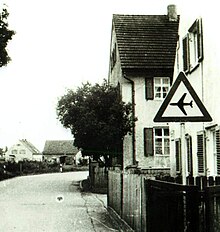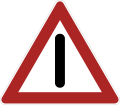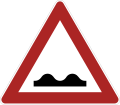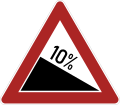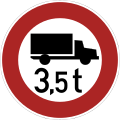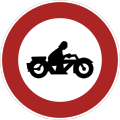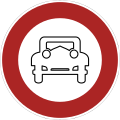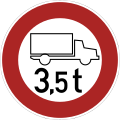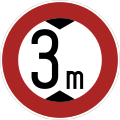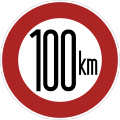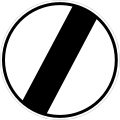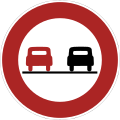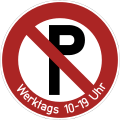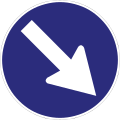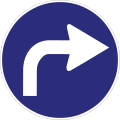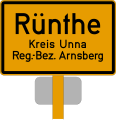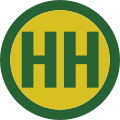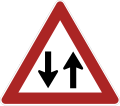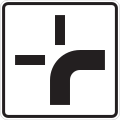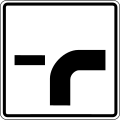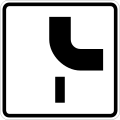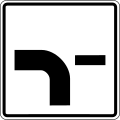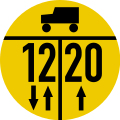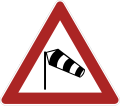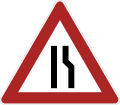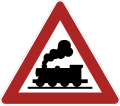Illustration of the traffic signs in the Federal Republic of Germany from 1956 to 1971
The picture table of the traffic signs in the Federal Republic of Germany from 1956 to 1971 shows the traffic signs in the Federal Republic of Germany as they were decided by the Road Traffic Act (StVO) in the version of March 29, 1956. This StVO came into force on May 1, 1956. In addition to the traffic signs of the StVO, the traffic-related sign arrangements in the traffic gazette and in the railway building and operating regulations (BO / EBO) are dealt with here. On the basis of the second general administrative regulation for the order management of federal highways from February 11, 1956, the motorway traffic signs are also dealt with here.
The StVO from 1956 was not designed as a new version of the regulations valid since 1937, but for the first time many symbols were revised and a number of new ones were introduced. Also new was the narrow white border that all characters now have. Quite a few images have been added that can be viewed in response to the ever-increasing traffic. A number of new design concepts in the subsequent revision from 1970 were anticipated at that time.
Due to the high number of new signs, the rampant " sign forest " was denounced early on and the question arose as to how many signs a motorist can expect at the same time. Tests showed that the receptivity of all test subjects was limited to two signs. Only half of the people consciously perceived a third sign.
Colours
As already confirmed in 1953, the traffic signs were again based on the RAL color register 840 R containing the official colors . This color register was introduced in 1940 and replaced the sample card valid since June 1932. The first post-war edition of this register was published in 1953.
The colors specified in the 840 R color register for the traffic signs were:
- RAL 3000 (red)
- RAL 1007 (yellow)
- RAL 5002 (blue)
- RAL 9005 (black)
- RAL 9001 (white)
The colors of the lettering were also based on the color register 840 R:
- RAL 2002 (red)
- RAL 6001 (green)
- RAL 9005 (black)
- RAL 9001 (white)
The current names of the RAL colors did not exist at that time. The posts of traffic signs should be white, those of place-name signs and signposts should be painted yellow. In addition to posts made of metal, reinforced concrete posts were also used.
typography
The typographical basis was the standard sheet DIN 1451 in its February 1951 edition. As a recommendation, it was determined that the fonts contained there should have a minimum line width of seven millimeters. Large letters should not be displayed under 50 millimeters high and small letters not under 35 millimeters high. Exceptions to these regulations have been set out on separate sample sheets.
Even in the official representation of DIN 1451 in the Federal Law Gazette, the official font was mostly not used. Almost always there the common “l” and “t” had no ending. In addition, the “t” head had a bevel facing to the left. In practice, too, the typographical rules were often not strictly adhered to. With certain letters, many characters show significant deviations and individualizations from the DIN specifications.
Manufacturing
As a rule, the signs were made of sheet steel or light metal sheet. Plastic remained a much less used subsurface. Wooden signs were hardly ever in use in 1964.
Application of the characters
While the number of enamel signs, which were expensive to manufacture, decreased significantly at this time, the screen printing process using stencils became increasingly popular. In 1969, low-cost, high-volume screen printing had been used in the production of traffic signs for around 20 years. Screen printing made it possible to print with sharp contours, had a high degree of lightfastness and demonstrated that the colors were very well anchored on the substrate to be printed. Metal signs were made with oven-dry screen printing inks and printed by machine or semi-manual. It was important to have a uniform color print, which was made possible by fine screen printing fabrics with 77 to 100 threads per centimeter.
When the StVO was introduced in 1956, the Scotchlite reflective film had also been used for a long time to equip traffic signs. In addition to sign painting, enamel and screen printing, this was the fourth process that was used at the time. The self-adhesive foils were available in different colors and were 0.2 millimeters thick. They had a smooth surface under which microscopic glass beads were embedded, which caused a self-reflecting effect when the light fell on them. The extensive manufacturing process prevented the film from spreading widely, as the films had to be cut out by hand.
In particular, the requirement to produce retroreflective signs at traffic junctions and in metropolitan areas led to the fact that many traffic signs were set up there in transparent design, which were illuminated from the inside with fluorescent lamps after dusk.
Rationalization and standardization measures
The Güteschutzgemeinschaft Verkehrszeichen (Quality Protection Association for Traffic Signs) worked for several years to develop the “Quality Conditions for Traffic Signs”, which came into force in September 1959. Associated with this was the award of a state-supported RAL quality mark , which could be awarded to manufacturers. This measure significantly improved the quality and standardization of the traffic signs.
In 1964, over 95 percent of all signs were attached to tubular metal rods, wooden posts or tubular frames. Just a few years earlier, every sign was usually specified as to whether a traffic sign had to be provided with mounting holes, what size the holes should be, and where on the sign the holes were to be drilled. In the case of enamel signs, for example, subsequent perforation was not even possible. For this reason, the "Standard Plans for the Punching and Installation of Traffic Signs" were adopted by the Industry Association for Traffic Signs in 1960. Just one year after the IVZ standard was published, 60 percent of all traffic signs were ordered according to its criteria.
Also in 1960 the RAL quality mark for traffic signs was issued by the then Federal Minister of Transport. This quality mark may only be applied if the traffic sign fully complies with the technical characteristics of the quality regulations. At the same time, the minister recognized the quality protection association for traffic signs and traffic facilities as a testing facility and agreed to the quality regulations set up by this association.
The long way to the new version of the road traffic regulations
The first steps towards a complete revision of the 1937 road traffic regulations were taken as early as the late 1950s. In February 1965, the political decision-makers were presented with the draft bill of a new order. It was to be published in the Federal Law Gazette in the summer of the same year and the final version was to come into effect at the beginning of 1966. A look at the editions of the 1965/66 Federal Law Gazette makes it clear that these announcements did not materialize. An early delay, which should not change the actual schedule for an introduction in 1966, was due to the criminal law discussion on the new version, which the Federal Ministry of Transport wanted to wait. Ultimately, however, the new version was not published until 1970 and came into force on March 1, 1971. However, a number of traffic signs of the new order were introduced before this date without this being announced in the Federal Law Gazettes.
particularities
- In Article 2 of the General Administrative Regulations for Road Traffic Regulations , it was confirmed in 1964 that in addition to § 3 StVO and the annex to the StVO, the decrees of the "General Inspector for German Roads" from April 15, 1938 on traffic signs and traffic facilities on the motorways and from 16 June 1938 remained in force through the uniform labeling of the place-name signs and signposts for local and long-term destinations. It was not until the new version of the StVO, which was passed on November 16, 1970 and came into force on March 1, 1971, that the signage of the motorways became part of the road traffic regulations and the old decrees from the period before 1945 were repealed.
- Image 27b for the arrangement of the roundabout, newly created by the ordinance of March 14, 1956, replaced the image 24a previously used for this purpose. With the new version of the StVO that came into force in 1971, Fig. 27b was no longer in the traffic sign catalog. The old order from before 1956 was now used. It was not until 2001 that the sign for a roundabout came back into the road traffic regulations.
- Regulations for the design of signposts to the federal motorways were issued until 1971 both within the framework of the StVO and by the bodies responsible for the federal motorways. In particular, the signposts to the federal motorways ordered by these two administrations existed parallel to one another with different design specifications. The reason for this fact lay in the two different areas of responsibility: the road areas that were covered by the road traffic regulations and those that were subject to the general administrative regulation for the administration of federal highways.
Advertising on the street
Any advertising and propaganda in the form of images, writing, light or sound along the streets outside of built-up areas was prohibited, especially if they were likely to distract the driver's attention or impair the flow of traffic.
I. Warning signs
(Pictures 1 to 10)
Marks for level crossings at rail height
(Pictures 4c to 10)
In the annual report of the Deutsche Bundesbahn for the year 1957 it is mentioned that all warning crosses at unbarred level crossings have been converted to the new, vertical arrangement.
II. Mandatory and prohibitive signs
(Pictures 11 to 31b)
III. Notice signs
(Pictures 32 to 51)
Signs for lanterns that don't burn all night
(Pictures 35 to 36)
More white lines and arrows on the road
Place-name sign
(Pictures 37 and 38)
Instead of the administrative district, since the introduction of the StVO, which came into effect on January 1, 1938, the term “ customs border district ” could be used in the border areas . There was no separate picture for this in the regulation.
Board for off-road locations, for information about rivers and sights
(Pictures 38a to 38c)
These panels measured 1250 × 333 millimeters with the edge.
Figures 39 and 40 were deleted without replacement.
Signpost for federal highways
Signpost for other paved roads
Signpost for unpaved roads
Federal highway license plate
Signpost to the federal motorway
Signpost for truck traffic
Trailblazer for truck traffic
Pre-signpost
(Pictures 46 to 51)
Signs for priority roads
IV. Sign for directing traffic in the event of road closures
(Pictures 53 to 56)
Signs mentioned in the StVO but not shown
For motorized road users, a maximum of two traffic orders or prohibitions were allowed to be combined on one sign. These had to be separated from each other by a red or white line. In the case of non-motorized road users, more than two commands or prohibitions were allowed to appear on the sign.
Additional boards
As the examples show, the design and wording of the additional tables were usually not completely standardized. So it was quite possible that signs with the same function were placed one behind the other in a different manufacturing method. In addition, the characters still lacked their own numbering.
Spielstraße - local traffic free
Signs that are not listed in the traffic sign catalog
The signs stop for trams and stop for motor lines were originally published in the Reichsverkehrsblatt 1939, but were not included in the road traffic regulations. The ordinance from the Reichsverkehrsblatt with the stop signs contained there was in the Federal Law Gazette with the signaling order for trams. Confirmed as still valid from June 14, 1958 . In 2006 this ordinance of 1939 was repealed.
Example of a stop sign for motor vehicle lines of the Kraftpost
Control facilities
The provisions of the provisional guidelines for the expansion of rural roads (RAL 1937) from December 1942 continued to apply in the Federal Republic in part. It said in Elsner's pocket yearbook for road construction 1954 : "For the shape and dimensions of the guide stones and milestones, the provisional guidelines for the expansion of rural roads (RAL) apply." The RAL 1937 guideline was published in March 1957 through the instructions for the arrangement and Execution of vertical guidance systems on federal trunk roads (HLB) has been replaced. It read: “Guiding stones, guide pegs and delineator posts as well as borders serve as vertical guide devices. Guard rails and handrails, as well as locking devices, guide boards and signposts . ”In addition, the light pillars that had been in use since the pre-war period were part of the guidance systems. These should show the boundaries of the traffic area and the course of the road in all weathers and in all seasons. It was now planned to replace the previous guide stones with guide posts. Light columns secured traffic islands and sidewalks.
The guide stones, which were still manufactured according to RAL 1937, were finally replaced in the further course of the 1950s by the guide posts introduced with the HLB from 1957 until the 1960s. According to HLB, the new delineator posts should be used in the future on roads with medium and heavy traffic in place of the guide stones and guide posts. Nevertheless, the road construction paperback from 1964 still gives precise information about the ashlar, the design of which has still not changed. In the overall Bavarian traffic plan of 1970 it is emphasized that the delineator posts are traffic-safe facilities compared to the "previously used guide stones", especially because of their design with reflectors. The road construction pocket book also describes the guide post made of wood, which, like the guide stone, also protrudes 0.70 meters above the top of the terrain. He also has a 0.20 meter high white head and below it a 0.12 meter wide black ring. In addition, like the delineator post, the delineator could now be equipped with reflectors.
The HLB defined black-yellow and black-white guide hatches on guide boards and guide signs that were used at special danger points. In the case of temporary obstacles such as construction site barriers, the color scheme had to be kept in red and white.
Additional arrangement of characters according to the specifications of the Federal Railroad Central Office in Munich
Announcement of the transitions
Speed limit at crossings without beacons. Shield combination according to the specifications of the Federal Railroad Central Office in Munich .
Marking the transitions
Gated level crossing (erected by December 31, 1960)
Crossings with warning lights and flashing lights (installed by December 31, 1960)
Subsequent changes and additions to the StVO and the BO / EBO up to the new regulation in 1970
1957
February
The approval of the yellow signs for war cemeteries was defined by a ministerial decree of January 22, 1957, which was published in the Verkehrsblatt .
May
The approval of the green signs for tent sites was defined by a ministerial decree published in the Verkehrsblatt on May 25, 1957 . The signs were not part of the traffic sign catalog and had to be procured and set up locally.
In the annual report of the Deutsche Bundesbahn for 1957 it is reported that the older design warning light systems have been replaced by modern flashing light systems and that all warning crosses at unrestricted level crossings have been converted to the new, vertical arrangement. The fact that the dismantling of old warning light systems was far from complete is proven by the Federal Government's annual report from 1960. There it is mentioned again that older warning light systems were replaced by new flashing light systems. Ultimately, the old warning crosses and warning lights were allowed to be used until the end of 1963.
1958
June
By decision of the Federal Ministry of Transport on June 13, 1958, the introduction of unofficial signposts in white to local destinations was published in the Verkehrsblatt . The client had to pay the costs for these signs.
September
At the International Road Safety Congress, which took place in Copenhagen from September 21 to 23, 1958, Fritz Heller , Ministerialrat of the Federal Ministry of Transport, announced the introduction of European road numbering.
1959
According to a statement by the Federal Ministry of Transport on February 26, 1959, additional panels for a "kinking right of way" were presented for the first time. The legal basis for this regulation remained problematic at this point in time. Nevertheless, the signs spread very quickly, especially in traffic centers. The additional signs were attached under the priority sign Fig. 52.
1960
With the amendment to the Road Traffic Act of July 7, 1960, the following new or changed signs came into force on August 1, 1960:
The approval of white signs for church services was defined by a ministerial decree of July 19, 1960, which was announced in the Verkehrsblatt and published on August 31, 1960. Another decree of June 6, 1961 made it clear that an additional sign could be attached under the information sign, which gave the name of the church or explained how to get there. The communities themselves had to bear the costs of setting up the signs.
1961
January
On January 1, 1961, a new ordinance amending the Railway Construction and Operating Regulations (BO) came into force. Among other things, terms relating to the railway-specific traffic and warning signs were changed at that time. "Warning lights" became "flashing lights" and the "warning cross" was now called "St. Andrew's Cross". In addition, new dimensions for the signal screen were specified. A lightning arrow in the middle of the St. Andrew's cross indicated that the railway line had an electrical contact line. Until December 31, 1963, the previous warning crosses and warning lights could still be used. On January 1, 1964, the Ordinance Implementing the Law on Crossings of Railways and Roads of July 5, 1939 and the Second Ordinance on Implementation of the Law on Crossings of Railways and Roads of August 30, 1941 ceased to be in force as federal law. The pictures 4c, 4f and 4g of the road traffic regulations fell out of the railway building and operating regulations and thus from the StVO and were replaced by picture 4 e - in the railway building and operating regulations picture 1.
With the new amendment to the road traffic regulations, which had already been decreed on December 29, 1960, new, revised additional panels on the "Kinkende Vorfahrt", which could be attached under Figures 30, 30a, 44, 52, followed the day after their announcement in the Federal Law Gazette. The "kinking right of way" was placed on a new legal basis by being anchored in the StVO. The new signs replaced an older requirement that provided for right-of-way signs with additional signs.
March
Yellow round signs that gave information about the military load-bearing capacity of passable structures were not listed in the StVO . The first signs had already been put up in 1960. The regulations for this were only specified in the "Guidelines for the marking of bridges, ferries and vehicles for military road traffic according to STANAG 2010" of March 27, 1961 introduced by the then Federal Ministry of Defense . Signs of this type had no meaning for civil traffic. The regulations for setting up the signs were uniformly regulated throughout Germany, but there were also additional regulations that could be issued by the federal states. In Bavaria, for example, it was forbidden to make the signs out of wood. The visual design of the symbols could also differ greatly from one another, even if the recommended representations (see below) were mostly used. The color of the signs was also different. A light yellow shade or a yellow-orange color was common.
1962
Based on picture 38c, the sign for concentration camp cemeteries was issued on September 25, 1962 by the Federal Minister of Transport. The symbol was also used for concentration camp memorials.
1964
With the StVO change of April 30, 1964, among other things, a slightly changed image 30c was introduced, which gave priority to pedestrians on crossings over automobile traffic. In the Verkehrsblatt 1964, p. 251, the Federal Transport Minister announced guidelines for the implementation of traffic-directing tasks by the road traffic authorities . To this end, the Federal Law Gazette published a picture of how to divert the needs of motorway traffic. This ordinance came into force on June 1, 1964.
1965
In Verkehrsblatt March 30, 1965 two traffic signs have been used to identify the pedestrian crossings published that were expected across required for the planned revision of the Highway Code. For the first time, instead of the term “image”, the term “symbol” has been introduced.
A special motorway service area sign was put up from 1965. It was supposed to remind of the expulsion areas of the Germans . In 1964, the then Federal Minister of Transport, Hans-Christoph Seebohm, submitted a request to name rest areas accordingly.
At the federal highway 8 , along the 30-kilometer-long section Weyarn – Munich, a then new type of remote-controlled traffic sign system from Siemens was installed at intervals of two kilometers . From the Holzkirchen autobahn police station, it was possible to influence the traffic remotely, so that it could be kept flowing during traffic peaks. The aim was to make better use of the existing lanes. The remote control commands were sent from the control center to the systems using the TST20 audio frequency multiplex system developed by Siemens .
1966
After the planned introduction of a new version of the StVO for 1966 was delayed until further notice, a number of selected new traffic signs were approved. The corresponding circular of the Federal Minister of Transport for this publication was dated December 29, 1965. It was published on January 31, 1966. Some traffic signs, such as the white inner-city signposts introduced in 1958 and the student pilot sign, which were not previously part of the traffic sign catalog and were procured locally had to be set up, now became an official part of the road traffic regulations.
In addition, the additional sign "Frost damage" and "diversion" was introduced in 1966 by the traffic journal.
1967
April
A new traffic sign emerged from a competition organized by the Association of German Hiking Clubs in 1965, which showed a “fresh hiking couple” and was based on Figure 32. The sign “Wanderparkplatz” was first published on April 7, 1967 in the traffic gazette of the Federal Ministry of Transport. The decree of the Ministry of Food, Agriculture, Viticulture and Forestry (No. V 794. 4–342 of September 6, 1967) also went into this. When the StVO was presented in 1970, the sign was not shown in the Federal Law Gazette, but was re-published in the traffic sign catalog.
May
On May 28, 1967, the new railway building and operating regulations of May 8, 1967 came into force. This has now been abbreviated as "EBO". All signs to secure the level crossings, as stipulated in the ordinance amending the railway building and operating regulations of January 1, 1961, remained in force. A light signal with the color sequence yellow-red was added in Figure 4.
1968
March
On March 29, 1968, the traffic gazette decreed the use of the new motorway symbol in traffic signs according to Fig. 45 StVO . After that, instead of the word "Autobahn", the symbol could be used, as it had been introduced in the image for "Beginning of the Autobahn" introduced in 1966. A sample illustration of the new character combination was not presented.
June
In the Verkehrsblatt , the signposts for diversions that had already been introduced in 1964 were specified again and published on June 12, 1968 in a slightly different version.
November
On November 8, 1968, a regulation was introduced into the StVO which obliges motorists to always carry a reflective warning triangle in the car, as shown in Figure 1.
1969
1970
With the ordinance on protection against rabies of March 13, 1970 , two special signs not listed in the StVO were decreed, which could be ordered by the authorities if necessary. The wild rabies sign was placed after rabies cases were detected in wild animals. The rabies shield was attached to dogs and cats in appropriate cases.
Locally arranged character combinations
Locally arranged character combinations that were not included in this form in the road traffic regulations.
Motorway signage
The signage for motorways was not included in the amendment and was taken over as federal law from the “Decree on traffic signs and facilities on Reichsautobahnen of April 15, 1938”. This was confirmed by § 3 of the “First General Administrative Regulations for Order Management on Federal Highways (1. AVVFStr.) Of July 3, 1951”, amended by the “Second General Administrative Regulations for Order Management on Federal Highways (2. AVVF Street) of 11 February 1956”. The pre-war coloring was also retained. The color RAL 5002 corresponded to RAL 32h, which was used in the 1930s. As a rule, the large motorway signs were initially made of wood and plywood. They had a white border, which could either be painted on or made as a white painted wooden frame. However, the innovations of the late 1950s also included the ever faster spreading of motorway signs made from extruded aluminum profiles. They were initially made based on the American model. Despite the rapid spread of these much more durable signs, the wooden motorway signs were still part of the street scene on older routes at the end of the 1960s.
Boards on the right edge of the road
Even after the introduction of a new generation of signs in 1958, in which, for example, the distances between the beacons were changed, the older signs remained in use in the early 1970s. With the exception of a few newly introduced signs, the blue boards and boats took over the requirements of the pre-war period.
Subsequent changes and additions to the decrees and administrative regulations
1958
At the International Road Safety Congress, which took place in Copenhagen from September 21 to 23, 1958, based on the "Second General Administrative Regulation for Order Management of Federal Highways of February 11, 1956", new traffic signs and new design specifications for Motorways announced by Fritz Heller , Ministerialrat from the Federal Ministry of Transport. At the same time, the road markings were adapted to the European convention on road markings of December 13, 1957 and to the recommendations of expert groups, and the introduction of European road numbering was announced.
Special dimensions for the typesetting on the signs were not prescribed. The sign manufacturers should adhere to the golden ratio when it comes to the proportions . The font had to comply with DIN standard 1451, whereby the fonts narrow, medium and wide could be used. The medium and wide letters were preferable for reasons of beauty.
All in all, even after 1958, the required design and typography were not always evident on the motorway signs - as in the past - although a standardization became apparent towards the end of the 1960s.
- Signs on the right side of the road
- Signpost on a sign bridge
- Signs in the median
- Signs at the entrance to the motorway
More motorway signs
- Signs on the right side of the road
- Signs in the median
literature
- Forschungsgesellschaft für das Straßenwesen (Ed.): Leaflet for the arrangement of lane markings on city streets , 1956.
- Fritz Heller: Rules for the dimensioning and design of labeled traffic signs . In: Straße and Autobahn 12 (1957), pp. 455-465.
- Road markings, guiding devices and protective devices. Instructions for the arrangement and execution of lane markings on federal trunk roads (HMB); Instructions for the arrangement and design of vertical guidance systems (HLB); Guidelines for repellent protective devices on federal highways; Guidelines for the erection of anti-glare fences on federal motorways , special print from: Road construction from AZ , Erich Schmidt Verlag, Bielefeld 1970.
Web links
Remarks
- ^ Bundesgesetzblatt , Part I, year 1956, No. 19, date of issue: Bonn, April 30, 1956, p. 217.
- ↑ The visual identification of the traffic signs is limited. In: The Public Health Service. 24, 1962 p. 258.
- ^ Federal Law Gazette, Part I, year 1953, No. 56, date of issue: Bonn, September 3, 1953, p. 1217.
- ↑ Bundesgesetzblatt, year 1956, No. 19, date of issue: Bonn, April 30, 1956, pp. 344-345.
- ↑ Johannes Denecke: Lackfarben 1932-1945. In: Johannes Denecke Camouflage paints of the German army 1914 to today , Bernard & Graefe, Bonn 1999, ISBN 3-7637-5990-5 . Pp. 104-106.
- ↑ Bundesgesetzblatt, year 1956, No. 19, date of issue: Bonn, April 30, 1956, p. 316.
- ↑ Bundesgesetzblatt, year 1956, No. 19, date of issue: Bonn, April 30, 1956, p. 345.
- ^ Adolf Meyer: Concrete goods for road construction. Bauverlag, 2nd edition, Wiesbaden 1963. p. 82.
- ↑ Design and execution of traffic signs . In: Straße und Autobahn , Issue 4, 1980, p. 287.
- ↑ Federal Law Gazette, year 1956, No. 19, date of issue: Bonn, April 30, 1956, p. 344.
- ^ Arthur Lämmlein: Road construction paperback. Franckh'sche Verlagshandlung, Stuttgart 1964. p. 435.
- ↑ a b Eberhard Lendle: The production of traffic signs with the help of the screen printing process. In: Druck - Print. Archive for printing technology 12/1969, Keppler, Heusenstamm 1969, p. 990.
- ↑ Industry reports: Scotchlite reflective film for sea mark purposes In: Hansa. Central organ for shipping, shipbuilding, harbor , 94, 29/30, 1957, p. 1640, published weekly .
- ^ W. Killing: Rationalization measures in the German traffic sign industry and their successes. In: road and highway. No. 1, 1964, p. 30; Ernst ceiling: traffic signs . In: Der Tiefbau 64, (1964), p. 153 ff .; here p. 155.
- ^ W. Killing: Rationalization measures in the German traffic sign industry and their successes. In: road and highway. No. 1, 1964, pp. 30-31.
- ↑ Peter Stähle: Seebohms new rules - secrecy about the new traffic regulations . In: Die Zeit , 17 of April 23, 1965. p. 11.
- ↑ Bulletin of the Press and Information Office of the Federal Government. 78, May 5, 1965, p. 670.
- ↑ Bundesgesetzblatt 108, 1, Bonn, December 5, 1970, p. 1611.
- ^ Road traffic law (= Beck's short comments 5) Beck, Munich 1966, pp. 114–115.
- ^ Road traffic law (= Beck's short comments 5) Beck, Munich 1966, p. 114.
- ↑ Federal Law Gazette 2000 Part I No. 54, issued in Bonn on December 14, 2000
- ↑ Bundesgesetzblatt, year 1956, No. 19, date of issue: Bonn, April 30, 1956, p. 337.
- ↑ a b Annual report of the Deutsche Bundesbahn for the 1957 financial year. 1957, p. 34.
- ↑ Ernst ceiling: Traffic safety measures and the new StVO . In: Tiefbau Ingenieurbau Straßenbau 3, March 1972, p. 189 ff .; here: In: p. 202.
- ^ Kurt Kottenberg: The pedestrian in traffic. In: Der Städtetag , April 1964, pp. 151–153, here: p. 152.
- ↑ a b Federal Law Gazette, year 1964, No. 22, date of issue: Bonn, May 9, 1964, pp. 305–307 with illustrations of the new symbols.
- ^ Beck's short comments: Johannes Floegel, Fritz Hartung: Road traffic law. Road traffic regulations, road traffic approval regulations. Road Traffic Act, provisions of the StGB, the StPO and the JGG for the protection of train path traffic with an appendix of additional regulations. 8th edition, CH Beck, Munich 1966. p. 138
- ^ Ordinance on behavior in road traffic (Road Traffic Regulations - StVO -) of November 13, 1937 . In: Reichsgesetzblatt , part 1, year 1937, no. 56, Berlin, November 16, 1937, p. 1193; Ordinance amending the Road Traffic Licensing Regulations and the Road Traffic Regulations of August 24, 1953. In: Federal Law Gazette, Part 1, No. 56, Bonn, September 3, 1953, p. 1216.
- ↑ Bundesgesetzblatt, year 1956, No. 19, date of issue: Bonn, April 30, 1956, p. 368.
- ↑ a b c The Federal Minister of Transport (March 29, 1968): Use of the new motorway symbol in traffic signs according to Fig. 45 StVO . In: Straßenverkehrstechnik , 7/8, 1968. P. 82.
- ^ Bundesgesetzblatt , Part I, year 1956, No. 19, date of issue: Bonn, April 30, 1956, p. 341.
- ^ Bundesgesetzblatt , Part I, year 1956, No. 19, date of issue: Bonn, April 30, 1956, p. 340.
- ^ Reichsverkehrsblatt B, No. 33 of July 29, 1939
- ↑ Signal regulations for trams . In: Bundesgesetzblatt , Part 1, No. 33, Bonn on June 26, 1958, pp. 397–398; here: p. 397.
- ^ First law on the adjustment of federal law in the area of responsibility of the Federal Ministry for Transport, Building and Urban Development. From September 19, 2006. Article 27: Repeal of the regulation on the introduction of uniform stop signs for trams and motor vehicle lines. In: Bundesgesetzblatt I, No. 44, Bonn on September 30, 2006, pp. 2146–2153; here: p. 2148 and p. 2153.
- ^ Elsner's pocket yearbook for road construction 1954 . Elsner 1954, p. 209.
- ^ Adolf Meyer: Concrete goods for road construction . Bauverlag, Wiesbaden / Berlin 1963, p. 75.
- ^ Arthur Lämmlein (Ed.): Straßenbau-Taschenbuch Franckh, Stuttgart 1964, p. 426.
- ^ Free State of Bavaria: General Transport Plan Bavaria Bavarian State Government, 1970, p. 90.
- ↑ a b Federal Law Gazette, year 1960, No. 35, p. 527.
- ↑ Signs for war cemeteries . In: Verkehrsblatt , 1957, p. 105.
- ^ War cemetery in the cemetery at Kottendorfer Feld in Wulfen , Wulfen-Wiki, accessed on April 7, 2016.
- ↑ Signs for tent sites . In: Verkehrsblatt , 1957, p. 273.
- ↑ German Politics 1960. Annual Report of the Federal Government , 1960, p. 314.
- ↑ Bundesgesetzblatt , 61, Part 2, Bonn, on December 28, 1960, pp. 2421–2423; here: pp. 2421–2422
- ↑ Unofficial signs . In: Verkehrsblatt , 1958, p. 431.
- ↑ a b c d e f g h i j k l m road traffic law (= Beck's short comments 5) Beck, Munich 1966, p. 149.
- ↑ a b Fritz Heller: New versions of markings and traffic signs on the motorways in the Federal Republic of Germany . In: Die Autostrasse 4, 1959, p. 76.
- ↑ The kinking direction of approach and its signage. In: Verkehrsblatt , 1959, p. 146.
- ↑ Broken right . In: Der Spiegel 48, 1960, pp. 93–95.
- ^ Beck's short comments: Johannes Floegel, Fritz Hartung: Road traffic law. Road traffic regulations, road traffic approval regulations. Road Traffic Act, provisions of the StGB, the StPO and the JGG for the protection of road traffic with an appendix of additional regulations. 8th edition, CH Beck, Munich 1966. p. 138
- ^ A b G. Hetzel: Change of the regulations for the road traffic . In: Technical Monitoring , Volume 2, 1961, pp. 29-31; here: p. 30.
- ↑ Signs for church services . In: Verkehrsblatt , Issue 16, 1960, p. 333.
- ↑ Bundesgesetzblatt , 61, Part 2, Bonn, on December 28, 1960, pp. 2421–2423; here: pp. 2421–2422
- ↑ Bundesgesetzblatt , 51, Part 1, Bonn, on August 20, 1963, pp. 681–684; here: p. 684.
- ↑ Bundesgesetzblatt, year 1961, No. 1, date of issue: Bonn, January 5, 1961, p. 8 with illustration of the new symbol.
- ↑ Verkehrsblatt , 1961, p. 22
- ↑ Kinking right of way. In: Decisions of the Federal Court of Justice in Civil Matters , Volume 44, Carl Heymanns Verlag, Cologne, Berlin 1966, p. 260
- ^ Road traffic law (= Beck's short comments 5) Beck, Munich 1966, p. 115.
- ↑ Signs for concentration camp cemeteries . In: Verkehrsblatt , Issue 19, 1962, p. 539.
- ^ Beck's short comments: Johannes Floegel, Fritz Hartung: Road traffic law. Road traffic regulations, road traffic approval regulations. Road Traffic Act, provisions of the StGB, the StPO and the JGG for the protection of train path traffic with an appendix of additional regulations. 8th edition, CH Beck, Munich 1966. p. 114.
- ↑ See also: The Federal Minister of Transport: Establishment of diversions . In: Straße und Autobahn , Volume 15, 1964, p. 215.
- ↑ Marking of the pedestrian crossings . In: Verkehrsblatt , Issue 7, 1965, pp. 200 ff.
- ↑ Claudia Pinl : Warthe in the Westerwald. Culture of remembrance at West German motorway parking lots. In: information. Society for Folklore in Rhineland-Palatinate , 20, 2006, pp. 52–59; here: pp. 55–56.
- ↑ Traffic signs on the Holzkirchen – Munich motorway. Control of weekend traffic even outside the city . In: Der Tiefbau 8, August 1965, pp. 802 ff .; here: p. 802.
- ↑ Verkehrsblatt , 1966, p. 49 ff.
- ↑ StV 2 No. 2100 BV / 65
- ↑ Use of traffic signs from the draft of a new road traffic regulation . In: Verkehrsblatt 2, 1966, p. 49.
- ↑ a b Road Traffic Law (= Beck's short comments 5) Beck, Munich 1966, p. 140.
- ↑ Use of traffic signs from the draft of a new StVO. In: Verkehrsblatt , 1966, 20, p. 49 ff .: here: p. 52.
- ↑ a b Road Traffic Law. Road Traffic Regulations, Road Traffic Licensing Regulations, Road Traffic Act, provisions of the StGB, the StPO and the JGG for the protection of road traffic with an appendix of supplementary regulations (= Beck'sche Kurz-Comments Vol. 5) Beck, Munich 1966, p. 2334 .
- ↑ Verkehrsblatt 23, 1966, p. 642.
- ^ Georg Fahrbach : The new traffic sign for hikers' parking spaces . In: German Hiking 1967, p. 63.
- ↑ Traffic signs for parking spaces for hikers . In: Verkehrsblatt 1967, No. 128, p. 298.
- ↑ Rolf Zundel, Dietrich Kettler: Landscape maintenance and recreational measures in the forest. Experiences and recommendations for the European Year of Nature Conservation 1970. Freiburg im Breisgau 1970. p. 45.
- ^ Railway building and operating regulations (EBO) . In: Federal Law Gazette Part II, 1967, No. 20 of May 12, 1967, pp. 1563-1603; here: p. 1592.
- ↑ Use of the new motorway symbol in traffic signs according to Fig. 45 StVO . In: Verkehrsblatt , Issue 8, 1968, p. 159.
- ↑ Guidelines for traffic control measures of the road traffic authorities, the road construction authorities and the police (traffic control guidelines) . In: Verkehrsblatt , Issue 11, 1968, p. 239 ff .; here: pp. 242–243.
- ↑ Ordinance amending the Vehicle Parts Ordinance. In: Bundesgesetzblatt, year 1968, no. 77, date of issue: Bonn, November 13, 1968, pp. 1136–1137.
- ↑ Use of the nine symbols for highways . In: Straßenverkehrstechnik , 4, 1969, p. 120.
- ^ Ordinance on protection against rabies of March 13, 1970. In: Bundesgesetzblatt 24, Part 1, Bonn, on March 21, 1970, pp. 289–294; here: pp. 290–291.
- ↑ Federal Gazette No. 38
- ↑ Johannes Denecke: Lackfarben 1932-1945. In: Johannes Denecke Camouflage paints of the German army 1914 to today , Bernard & Graefe, Bonn 1999, ISBN 3-7637-5990-5 . Pp. 104-106; here: p. 104.
- ↑ Kurt Domke: Aluminum - a new material in road construction . In: Der Tiefbau 59, 1959, p. 31 ff .; here: p. 32.
- ^ Fritz Heller: New versions of markings and traffic signs on the motorways in the Federal Republic of Germany . In: Die Autostrasse 4, 1959, p. 65.
- ^ Fritz Heller: New versions of markings and traffic signs on the motorways in the Federal Republic of Germany . In: Die Autostrasse 4, 1959, p. 74.



